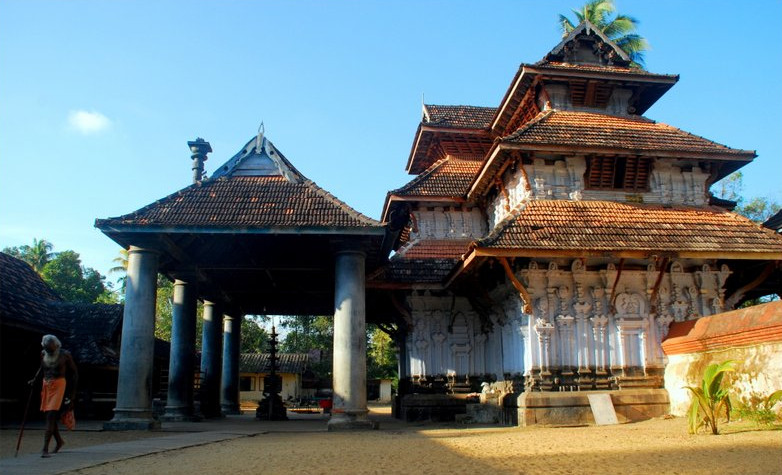There are two icons in this temple, considering as two “upadevas”, of them. This is the temple having the biggest number of Upadevas in Kerala. Master Ganapathy, Cheraman Perumal, Sundaramoorthy Nayanar, Brangiradi, Sandhyavelakkal Sivan, Palliyara Sivan, Sakthi Panchakshari, Bhagavathy, Goddess Parvathy, Lord Parameshwara, Prodhosha Nrithya, Sapthamathrukkal, Rishabham, Nandikeshan, Unni Thevar, Lord Ayyappan, Lord Hanuman, Nagaraja, Lord Pashupathi, Nadakkal Sivan, Lord Subramanyan, Goddess Durga Bhagavathy, Goddess Ganga, Konnakkal Siva, Kottarathil Thevar, Nagayakshi, Dakshinamoorthy, Althara Gopudan Swamy and so on are adored here alongside Lord Siva. Lord Mahadeva was the family deity of Chola kings.
Shrine’s History
This is the only Thevaram Paadal Petra Shiva sthalam in Kerala. Shiva is the family god of the Cochin Royal Family. The temple has very good mural paintings and is a protected monument by the Archaeological Survey of India. The temple has the oldest reference in history in Thevaram Hymns sung by Sundara Murthi Nayanar , one of the four Saiva Acharyas. The images of Sundara Murthi Nayanar, and of Cheraman Perumal Nayanar can also be seen in the temple premises. It is one of the oldest Shiva temples in South India, where Shiva is said to live along with his whole family.It was from here, Sundara Murthi Nayanar reached Kailash by sitting on a white elephant, sent by Lord Shiva on Adi Swathi day. He was followed on horseback by Seraman Perumal Nayanar.
On his way to Kailash, Sundara Murthi Nayanar sang a Padhigam which was sent back to Thiruvanchikulam on his request. The temple is associated with Chidambaram temple in Tamil Nadu. The capital city of the Kulasekharas, Mahodayapuram, was built around the temple; it was protected by high fortifications on all sides and had extensive pathways and palaces. This temple was attacked and damaged during Tipu Sultan’s invasion of Kerala; the copper roofing and gold and jewels were looted. Tipu’s Muslim soldiers fled the temple complex only after the arrival of the Travancore Army of Dalawa Keshavadas Pillai. The temple was rebuilt by Paliath Achan of Kochi/Perumpadappu Swaroopam.
Legends Associated with This Shrine
Tiru Anjaikalam is a gem among the Shiva sanctuaries of Tamilnadu sung by Saint Sundarar, otherwise called Nambi Aroorar, Thambiran Thozhar. He was conceived in Tiru Navalur in Villupuram locale. At the point when Cheraman went by Tiruvarur, Sundarar stretched out him all neighbourliness to him. He made a trip with the lord to numerous Shiva focuses in Chola, Pandya and Kongu locales in the state. He came to Kodungalur in Kerala and stayed with the ruler Cheraman. Proceeding with his voyage, he spread the superbness of Lord Shiva.
Shrine’s Map Location and How to Go There
By Road
Kodungallur is well connected by KSRTC buses and private transport buses.
By Rail
The nearest railhead to Kodungallur is located at Iringalakuda, at a distance of 16 km away. Iringalakuda is well connected with other major railway stations. It is in the main route connecting Kochi and Palaghat
By Air
The nearest airport to Kodungallur is at Nedumbassery International Airport at Kochi distance 35 km away.
Shrine Timings
4 am – 12 pm and 4:00 pm-8:30 pm
Events Celebrated at This Shrine
The temple priests perform the puja during festivals and on a daily basis. The temple rituals are performed four times a day; Kalasanthi at 8:00 a.m., Uchikalam at 12:00 a.m. and Sayarakshai at 6:00 p.m. There are weekly rituals like somavaram (Monday) and sukravaram (Friday), fortnightly rituals like pradosham, and monthly festivals like amavasai (new moon day), kiruthigai, pournami (full moon day) and sathurthi. Brahmotsavam during the Tamil month of Vaikasi (May – June) is the most important festivals of the temple.
